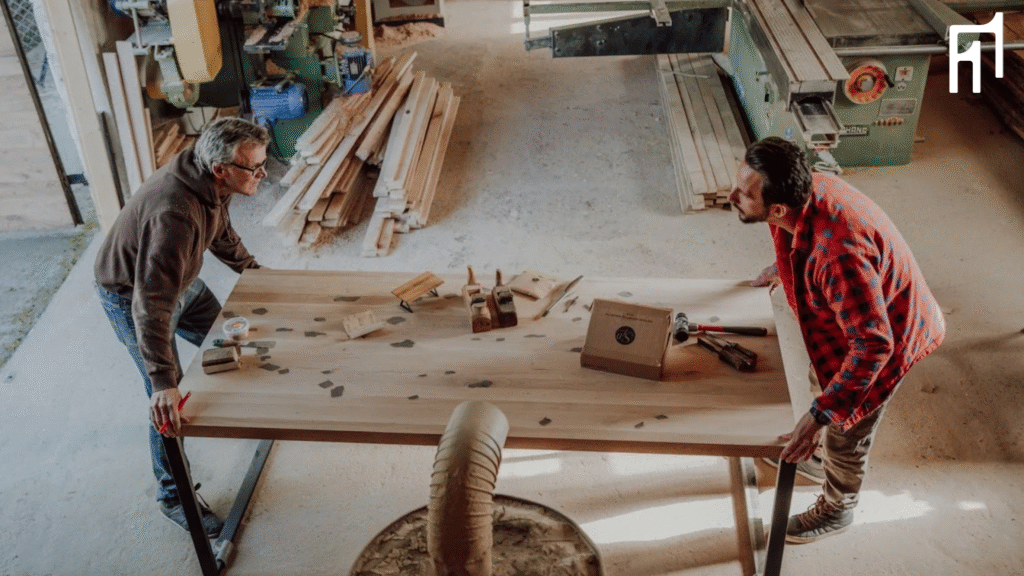Currently Empty: ₹0.00
Investing in high-quality wood furniture can transform your living space, offering both aesthetic appeal and long-lasting durability. However, distinguishing premium pieces from lower-quality options requires a keen eye and some insider knowledge. Whether you’re furnishing a new home in Pune or upgrading your current decor, this guide with premium furniture tips will help you identify top-tier wood furniture like a seasoned pro.
1. Solid Wood Identification
Clarity: Solid wood furniture is crafted entirely from natural timber, unlike engineered wood products like MDF or particleboard.
Conciseness: Look for visible growth rings and natural grain patterns, especially on the ends of the piece. These indicators suggest authenticity.
Credibility: Solid wood is renowned for its strength and longevity, often lasting for generations with proper care.
Compelling: Opting for solid wood identification ensures you’re investing in furniture that not only looks beautiful but also stands the test of time.
2. Examine the Joinery
Clarity: The way furniture pieces are joined together speaks volumes about their quality.
Conciseness: High-quality furniture often features dovetail or mortise-and-tenon joints, which are strong and durable. Avoid pieces held together solely by nails or staples.
Credibility: These traditional joinery methods have been used for centuries and are a hallmark of skilled craftsmanship.
Compelling: Furniture with superior joinery not only lasts longer but also adds a touch of artisanal charm to your home.
3. Inspect the Finish
Clarity: A furniture piece’s finish affects both its appearance and durability.
Conciseness: Look for a smooth, even finish without bubbles, streaks, or rough patches. Consistent coloration indicates careful application.
Credibility: A high-quality finish protects the wood from moisture and wear, preserving its beauty over time.
Compelling: A well-finished piece not only enhances the wood’s natural beauty but also ensures it remains a centerpiece in your home for years to come.

4. Check the Hardware
Clarity: Hardware includes handles, knobs, hinges, and drawer slides.
Conciseness: Ensure that hardware is securely attached and operates smoothly. High-quality pieces often use metal hardware rather than plastic.
Credibility: Durable hardware contributes to the overall functionality and longevity of the furniture.
Compelling: Quality hardware not only adds to the piece’s functionality but also complements its aesthetic, enhancing the overall appeal.
5. Assess the Weight
Clarity: Heavier furniture often indicates solid wood construction.
Conciseness: Lift or move the piece to gauge its weight; substantial weight suggests durability.
Credibility: Solid wood is denser than engineered alternatives, contributing to the furniture’s sturdiness.
Compelling: A weighty, well-built piece not only feels substantial but also provides peace of mind regarding its longevity.
6. Test for Stability
Clarity: Sturdy furniture should not wobble or creak under pressure.
Conciseness: Gently rock or press on the piece to check for movement; stability indicates quality construction.
Credibility: Stable furniture ensures safety and reliability in everyday use.
Compelling: Investing in stable pieces means fewer repairs and a safer environment for your family.
7. Identify the Wood Type
Clarity: Different woods have varying characteristics and durability.
Conciseness: Common high-quality woods include oak, maple, cherry, and walnut, each with distinct grain patterns and colors.
Credibility: Understanding wood types helps in assessing the furniture’s quality and suitability for your needs.
Compelling: Choosing the right wood type ensures your furniture aligns with your aesthetic preferences and functional requirements.
8. Evaluate the Surface
Clarity: A smooth, well-sanded surface is a sign of quality craftsmanship.
Conciseness: Run your hand over the furniture; it should feel even, without rough spots or splinters.
Credibility: A finely finished surface not only looks better but also resists dirt and damage more effectively.
Compelling: A smooth surface enhances both the tactile and visual appeal of your furniture, making it a joy to use daily.

9. Look for Certifications or Labels
Clarity: Certifications can indicate sustainable sourcing and manufacturing practices.
Conciseness: Labels like FSC (Forest Stewardship Council) certify that the wood is responsibly sourced.
Credibility: Certified furniture supports environmental sustainability and ethical practices.
Compelling: Choosing certified pieces allows you to furnish your home responsibly, contributing to global conservation efforts.
10. Consult with Experts
Clarity: When in doubt, seek professional advice.
Conciseness: Furniture experts or reputable retailers can provide insights into a piece’s quality and construction.
Credibility: Professionals have the experience and knowledge to guide you toward the best choices for your needs.
Compelling: Leveraging expert advice ensures your investment is sound, saving you time and potential future expenses.
Ready to elevate your home with premium wood furniture?
At Design Five11, we specialize in handcrafted pieces that combine timeless design with exceptional quality. Our expert artisans in Pune are dedicated to creating furniture that not only meets but exceeds your expectations. Visit our website or contact us today to discover how we can bring your vision to life.
.
Frequently Asked Questions
.
How can I identify high-quality wood furniture at first glance?
Look for signs like tight joinery, smooth finishes, and even grain patterns. High-quality wood furniture often has a sturdy feel, minimal visible screws or glue, and precise craftsmanship that sets it apart from mass-produced pieces.
What are some premium furniture tips for evaluating quality before buying?
Check drawer movement, test stability, inspect joinery (dovetail or mortise-and-tenon is best), and review the finish. A key premium furniture tip is to ask about the wood type and ensure it’s sustainably sourced.
How does wood grain help in identifying high-quality furniture?
Natural grain patterns are unique and continuous, especially on solid wood. Matching grain across panels and seamless joints are signs of high-quality wood furniture made with attention to detail.
What are the key techniques for solid wood identification?
To spot solid wood, check the edges and undersides for consistent grain. Tap the surface—solid wood has a deeper sound. Also, look for natural imperfections, as veneers tend to be too smooth. These solid wood identification tips help distinguish real wood from MDF or plywood.
Why is solid wood better than engineered wood in premium furniture?
Solid wood is durable, repairable, and develops character over time. Unlike engineered options, it doesn’t peel or delaminate, making it ideal for high-quality wood furniture that lasts generation



